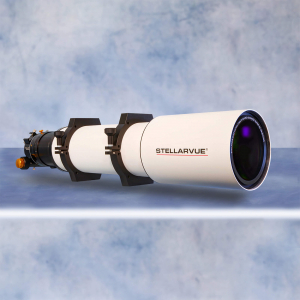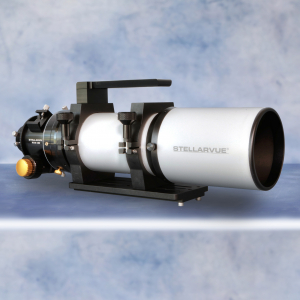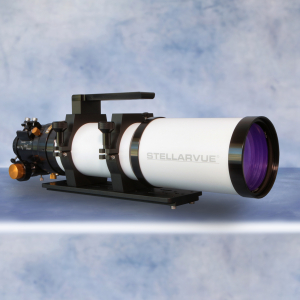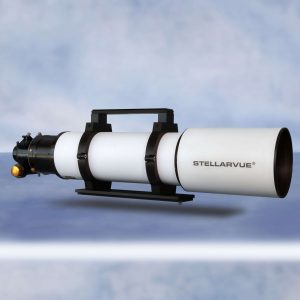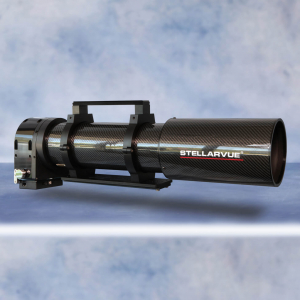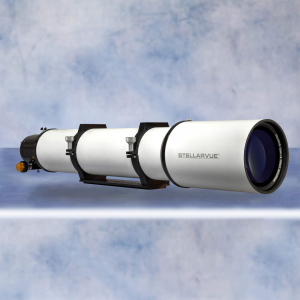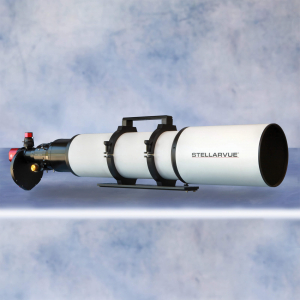STELLARVUE FOCUSER CHOICES
Our 80 mm - 127 mm telescopes are supplied with 3" focusers and our larger (130 - 180 mm) telescopes come with either a 3" Stellarvue, a 3.5" FeatherTouch or a 3.5" Moonlite Nitecrawler focuser.
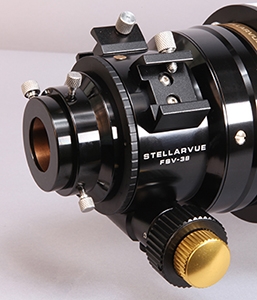 Features and Comparisons
Features and Comparisons 1. The Stellarvue Standard 3" dual speed, rack and pinion focuser: This is our most popular focuser. We have sold these for a decade and people who order them appreciate the smooth dual-speed action, the long (4.5") focuser drawtube travel and the price which is substantially less than the others. These come with a threaded drawtube that accepts our visual accessories and photographic flatteners with the exception of our new 130 - 180 reducer/flatteners. These are supplied with full manual rotation capability, 2" and 1.25" adapters, and two finderscope dovetail shoes. This focuser on our smaller telescopes completely eliminates the focuser-induced vignetting that can happen with smaller focusers. The durability is very good and it can handle all visual accessories and cameras up to full-frame in size.
It should be noted that when this focuser is used specifically with our larger telescopes (SVX130T-SVX180T), a full-framed or larger camera and our new Stellarvue reducer/flattener, some vignetting will occur. For this reason, we recommend a 3.5" focuser when using these larger telescopes and our new reducer/flatteners.
 2. The Starlight Instruments FeatherTouch 3.5" focuser: This upgrade is available with our 130mm - 180mm telescopes. These are supplied with full manual rotational capability, 4.5" of drawtube travel, 2" and 1.25" eyepiece adapters, one finderscope dovetail shoe, and Stellarvue-exclusive threaded photographic adapters that accomodate all of our photographic field flatteners and reducer/flatteners.
2. The Starlight Instruments FeatherTouch 3.5" focuser: This upgrade is available with our 130mm - 180mm telescopes. These are supplied with full manual rotational capability, 4.5" of drawtube travel, 2" and 1.25" eyepiece adapters, one finderscope dovetail shoe, and Stellarvue-exclusive threaded photographic adapters that accomodate all of our photographic field flatteners and reducer/flatteners. This is an American-made focuser that is as accurate as the focuser above, is slightly smoother and has a larger capacity. This is a large and extremely stable focuser that can lift heavier payloads including medium format cameras. Both Optec, Starlight and many other companies make motors for these focusers. We recommend this focuser for "hands-on" imagers who also want to use their telescope for visual use.
For our smaller telescopes (127 mm and smaller) we can supply the 3.0" FeatherTouch focuser as an upgrade. Both very accurately focus but with the Stellarvue you can hear the sound of the gears engaging if you listen very closely whereas the FeatherTouch is silent.This noise is normal and in no way impacts the ability to focus smoothly and accurately. Both focusers may be motorized. The Feather Touch costs $600 more.
Focuser selection: Most customers purchasing our smaller telescopes select the Stellarvue focuser and most purchasing our larger telescopes choose the larger Feather Touch. A listing of sales purcentages are shown below. This will give you a good idea of which focuser is most popular for each of our given models.
For our smaller telescopes (127 mm and smaller) we can supply the 3.0" FeatherTouch focuser as an upgrade. Both very accurately focus but with the Stellarvue you can hear the sound of the gears engaging if you listen very closely whereas the FeatherTouch is silent.This noise is normal and in no way impacts the ability to focus smoothly and accurately. Both focusers may be motorized. The Feather Touch costs $600 more.
Focuser selection: Most customers purchasing our smaller telescopes select the Stellarvue focuser and most purchasing our larger telescopes choose the larger Feather Touch. A listing of sales purcentages are shown below. This will give you a good idea of which focuser is most popular for each of our given models.
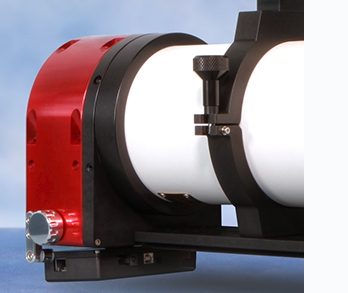 3. The Moonlite Nitecrawler Computerized focuser: Customers may upgrade to the 3.5" Moonlite Nitecrawler computerized focusers with our 130 - 180 mm telescopes and the 3.0" Moonlite Nitecrawler for our smaller telescopes. These come with various threaded extension tubes needed to meet focus with different accessories. Also included is a threaded adapter and 2" and 1.25" visual adapters.
3. The Moonlite Nitecrawler Computerized focuser: Customers may upgrade to the 3.5" Moonlite Nitecrawler computerized focusers with our 130 - 180 mm telescopes and the 3.0" Moonlite Nitecrawler for our smaller telescopes. These come with various threaded extension tubes needed to meet focus with different accessories. Also included is a threaded adapter and 2" and 1.25" visual adapters. This is an advanced, electronic, computerized focuser preferred by dedicated imagers. It is the most expensive upgrade, but for those who want perfection when it comes to imaging, this is considered one of the very best. This focuser has only 1/2" of travel. This is great for stability but it requires the use of various threaded extensions when converting to visual use or switching out a photographic field flattener for a reducer/flattener. Since most high-end imagers never look through their instrument and only use one flattener, this is usually no big deal.
For remote imaging this is practically a must as the focuser completely rotates on demand and focuses the imaging train precisely. The reason we recommend the 3.5" Feather Touch focuser for "hands-on" imagers who also want to use their telescope for visual use has to do with visual focusing. It can be difficult to focus eyepieces precisely with this electronic focuser since there is a lag time when manually focusing. This lag time issue has zero impact when imaging and for remote imagers, or those who want to operate their imaging telescope from indoors, this focuser is the "cat's meow."
For remote imaging this is practically a must as the focuser completely rotates on demand and focuses the imaging train precisely. The reason we recommend the 3.5" Feather Touch focuser for "hands-on" imagers who also want to use their telescope for visual use has to do with visual focusing. It can be difficult to focus eyepieces precisely with this electronic focuser since there is a lag time when manually focusing. This lag time issue has zero impact when imaging and for remote imagers, or those who want to operate their imaging telescope from indoors, this focuser is the "cat's meow."
*Unless specified otherwise, Moonlite Nitecrawler focusers will come in red.

